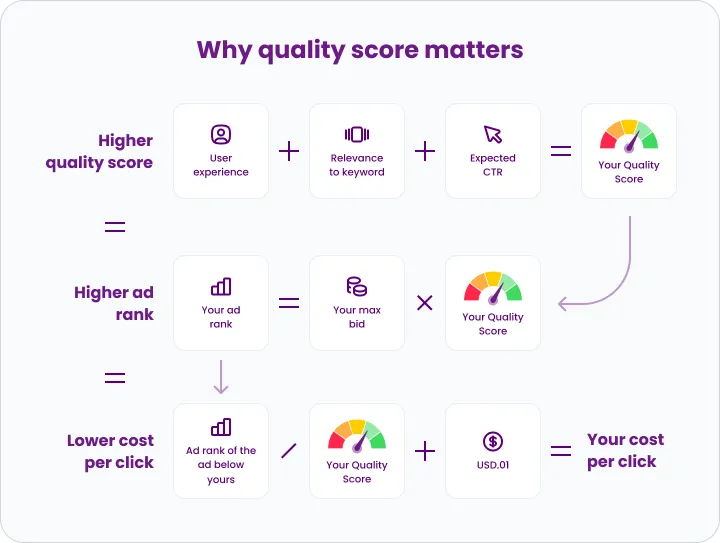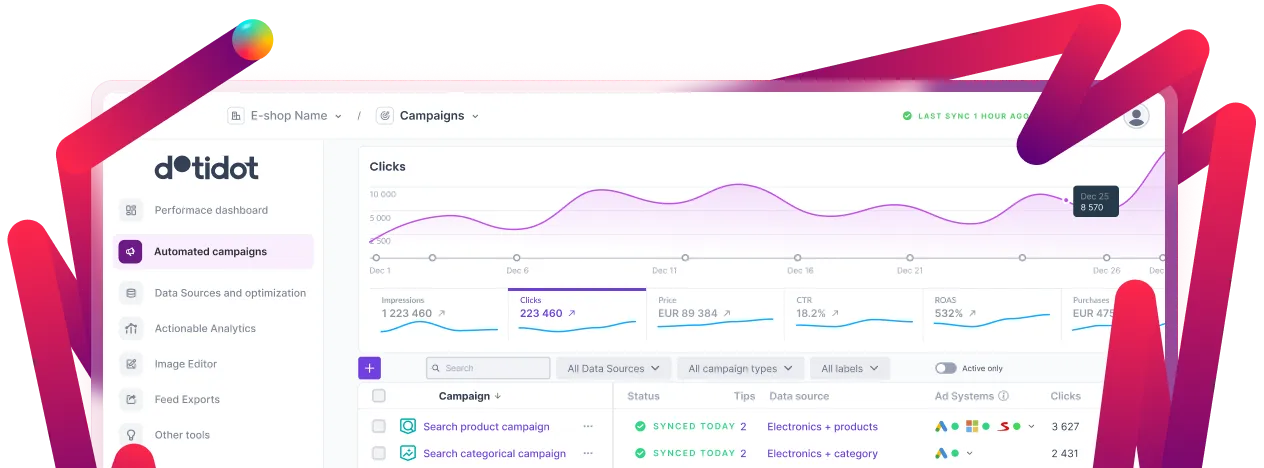Book a call with us







Google's goal is delivering the most relevant ads to the target audience. Quality Score helps determine how well your ad meets this goal. Think of Quality Score as feedback from Google on how well your ad aligns with users' needs and search intent.
Quality Score is determined by the combined performance of three main components:
Each of these components is rated as “Above average,” “Average,” or “Below average.” These ratings are based on a comparison with other advertisers whose ads were shown for the same keyword over the past 90 days.

Even if a broad match keyword has no impressions, it can still receive a Quality Score if a related exact match keyword in the same ad group has impressions within the last 90 days. The same Quality Score will be applied to both keywords if there are exact match searches corresponding to the broad match keyword.
A rating of “Average” or “Below average” in any of these components signals potential areas for improvement.


Improving your campaign's Quality Score will come with many positive results.
A higher Quality Score can lead to lower costs per click (CPC). Google rewards ads that are more relevant and provide a better user experience by reducing the amount advertisers need to pay for each click. This means that improving your Quality Score can help you achieve better results with a lower budget, maximizing your return on investment (ROI).

Quality Score plays a significant role in determining your ad’s position on the search results page. Ads with higher Quality Scores are more likely to appear in top positions, increasing their visibility and likelihood of being clicked. This enhanced visibility can drive more traffic to your site and increase the chances of conversions.
Focusing on Quality Score encourages you to create ads that are more relevant to your target audience. When your ads closely match what users are searching for, they are more likely to engage with your content. This relevance not only improves your Quality Score but also enhances user satisfaction and trust in your brand.
A key component of Quality Score is the landing page experience. By optimizing your landing pages to be more useful and relevant, you can significantly improve the user experience. Faster loading times, easy navigation, and high-quality content can all contribute to a better landing page experience, leading to higher engagement and conversion rates.
If you're looking for best practices to improve your landing page, read our article 9 steps to creating a high-converting PPC landing pages.
Effective keyword research starts by understanding what your audience is searching for. Use relevant keywords that specifically describe your products or services. Group similar keywords into closely related ad groups to ensure your ads are highly relevant. It's important to closely match your keywords with your ads for better performance.
Your work is never over, even after doing everything right from the beginning. Regularly review search term reports to identify new keywords to add or irrelevant ones to exclude using negative keywords. This approach not only improves Quality Score but also increases the likelihood of your ad appearing in relevant searches, boosting CTR and conversion rates.
TIP: If you want to have full control over your Quality Score, keep your keywords in exact match and phrase match. Broad match could trigger your ads for less relevant keywords.
You now have your keywords organized into tightly themed ad groups. It should be easy to discover what your audience is searching for. Your ads should communicate that you can provide the solution to their needs.
Also consider the desired action. Is your audience searching for:
Ensure that your ad resonates with their ultimate goal. Even if someone is searching for information, they might consider purchasing your service if it can eventually assist them. However, the conversion rate could be much lower.
Here are some best practices what you should mention in your ads:
TIP: Read the article Best practices for Responsive Search Ads to find even more tips.
Your work does not stop after someone clicks on your ad. They do expect something from the landing page that will eventually lead to satisfaction. If that does not happen, users will leave, making your campaign inefficient.
So what should you focus on when designing your landing page?
Users who click on your ad have a specific expectation based on the ad’s message. If your landing page doesn’t meet this expectation or is difficult to navigate, the user will likely leave without taking the desired action.
A positive user experience is essential for a high Quality Score. Focus on the design, navigation, and overall usability of your landing page.
Your landing page should guide users toward taking a specific action, whether it’s making a purchase, signing up, or downloading a resource. That is why you should use strong action-oriented language in your CTA to guide users what to do next.
And never forget to build trust as it can lead to better conversion rate. You can make your page look credible by adding:
TIP: We already have an article that fully covers optimizing PPC landing pages.
And that's it. Let's summarize it a bit. Use Google Quality Score as your campaign diagnostic tool and try to improve it to get even better results. The discount for CPC is really worth it and can make many campaigns much more effective.
